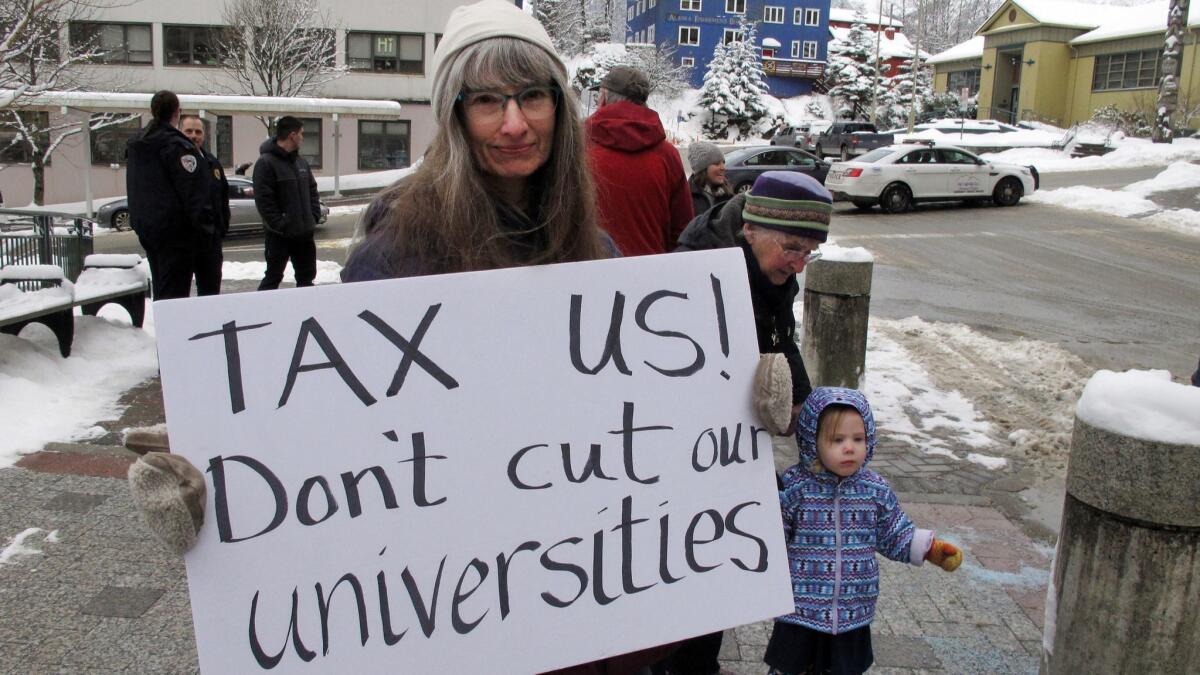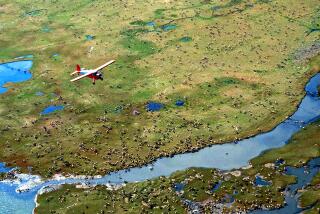Alaska’s cherished ferry system is on the chopping block as oil revenues decline
- Share via
Unless you have an airplane or private boat, there is only one way to reach many parts of the largest and wildest state: the Alaska ferry system.
The 10-vessel fleet transports 350,000 people and 100,000 vehicles a year, providing a lifeline that connects dozens of communities along 3,500 miles of rugged coastline.
Now the ferries are on the chopping block as Alaska faces its worst-ever budget crisis as a result of declining oil production.
As part of a plan to trim $1.6 billion from the state budget, the newly elected governor, Mike Dunleavy, has proposed cutting the ferry service so deeply that the state would have no choice but to shut it down or sell it.
The Alaska Marine Highway, as the system is officially called, has already halted ticket sales for the fall.
The system began in 1948 as the Chilkoot Motorship Lines, a private company that used a former U.S. Navy landing craft to link the cities of Haines, Skagway and the capital, Juneau. When the company soon fell into bankruptcy, the Alaska territorial government bought it. Expansions followed statehood in 1959.
It’s difficult to overstate the importance of the system in uniting the residents of this far-flung state. Before the ferry service, many coastal towns were little more than canneries with bunk houses, with company ships bringing workers basic supplies and occasional “frills” such as spices, cologne and church clothes.
Only five of the state’s 33 ferry ports are connected to a road system.
“The ferry is part of our survival,” said Alvin Osterback, mayor of the Aleutians East Borough in remote southwestern Alaska. “We are not connected to Alaska’s road system. Even slight cuts to the ferry system could severely limit our communities’ ability to travel and ship goods.”
One borough resident, Tina Anderson, who lives in the village of Sand Point, population 1,000, said she planned to put her car on a ferry to Seattle next month for recall repairs. The journey, 6,350 miles round trip, will cost $2,000 — a bargain compared with the $10,000 or more it would be using a private cargo ship.
“There’s just no way to get around out here without a ferry,” Anderson said. “It will make everything out here astronomically expensive, and things are already expensive as it is.”
The ferries are also a tourist attraction.
Every Friday afternoon in Bellingham, Wash., tourists who have shunned cruise ships and want a feel for the real Alaska mix with cannery workers and fishermen as they board for the three-day trip to Ketchikan.
Other routes deliver passengers to the small “rubber boot” fishing communities of the Alaska Panhandle.
All summer long, the ferry Tustumena — or Trusty Tusty, as locals call her — loads up in Homer, where the North American road system ends, for a voyage that parallels whale migration routes along the Aleutian Islands.
The passengers include bird-watchers, gold prospectors, crab men and workers for the fishing fleet in Dutch Harbor.
After the tourist season ends, high schools use the ferries to send their basketball teams to games.
At the root of the budget crisis is Alaska’s deep dependence on its oil industry. The state is the sole mineral rights holder, and with no state sales or income taxes, Alaska typically funds 85% of its budget with oil revenues.
The problem is that oil production on the North Slope has been in decline. Daily production, which peaked in 1988 at 2 million barrels, is now 482,000 barrels and falling.
The state has been dipping into its savings since 2013 to cover deficits.
Dunleavy, a Republican who campaigned on balancing the budget, has proposed major cuts to social services, healthcare and public education, including a 41% reduction in spending on the state university system.
The aim is to reduce the state budget by a third.

Cutting the ferry system budget from $140 million to $44 million, as Dunleavy has proposed, would leave it without operational funds after Oct. 1.
The proposal comes as two new ferries, purchased for $120 million, are scheduled to join the fleet in May.
The apparent foolhardiness of simply abandoning the ferry system — along with the sheer size of cuts in other areas — has convinced some observers that Dunleavy’s proposal is just an opening move in a bigger negotiation.
“I don’t know anybody who supports cutting a budget by a third,” Alaska House Speaker Bryce Edgmon said. “To cut the budget by a third makes it very difficult to survive.”
Bert Cottle, the mayor of Wasilla, called the proposed cuts a “win-win for Dunleavy,” who is from the town.
“He can show his supporters he fought for what he campaigned for and at the same time start a conversation on the future of finances in this state.”
Still, Alaska has a history of walking away from its own costly infrastructure.
In one case, the state invested $100 million in a barley farming scheme, laying railroad tracks, buying train cars and building a grain elevator before pulled the plug in 1983.
There is one huge source of money that almost certainly will not be used to cover the gap between revenue and expenses in the state budget.
It’s the $64-billion Alaska Permanent Fund, which is built on oil proceeds — a quarter of each year’s revenue goes into it — and investments. The fund is the source of the state’s famous dividend, the payment made each year since 1982 to every man, woman and child who has lived in the state at least two years and has no criminal record.
Last year the dividend was $1,600 a person. Dunleavy, who campaigned on providing a “super-sized” dividend, has promised to raise it to about $3,000 a person.
That would be about $1.6 billion total — the same amount the governor is trying to cut.
As for the ferry system, spokeswoman Aurah Landau said the search is on for a consulting firm to advise the state on options for scaling it back or selling it.
A private company, the Inter-Island Ferry Authority, already handles service between Prince of Wales Island and the rest of the state, though it receives $500,000 a year in state subsidies.
Coppock is a special correspondent.
More to Read
Sign up for Essential California
The most important California stories and recommendations in your inbox every morning.
You may occasionally receive promotional content from the Los Angeles Times.










